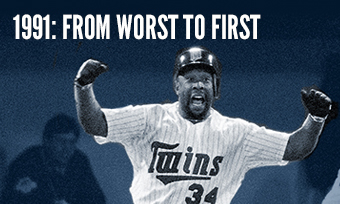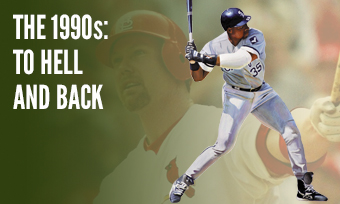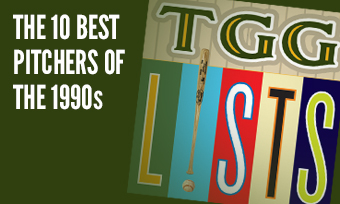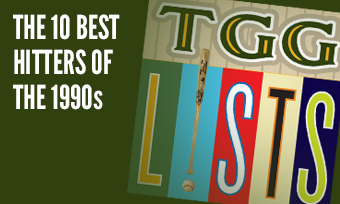The Yearly Reader
Leaders and Honors, 1991
Our list of baseball’s top 10 hitters and pitchers in both the American League and National League for the 1991 baseball season, as well as the awards and honors given to the game’s top achievers of the year.
The National League’s Top 10 Hitters, 1991
Bold type in brick red indicates league leader.
1. Barry Bonds, Pittsburgh
Key Numbers: .292 average, 95 runs, 28 doubles, 5 triples, 25 home runs, 116 RBIs, 107 walks, 25 intentional walks, 43 stolen bases, .410 on-base percentage.
If not for a strike in 1994 and injury in 1999, this would have been the second of 15 straight years in which Bonds knocked in 100 or more runs. He was edged out by Terry Pendleton in a bid for his second straight MVP.
2. Howard Johnson, New York
Key Numbers: .259 average, 108 runs, 34 doubles, 38 home runs, 117 RBIs, 30 stolen bases, 15 sacrifice flies.
HoJo became the first switch hitter to lead the NL in home runs and the second player (after Bobby Bonds) to reach 30-30 for a third time.
3. Ryne Sandberg, Chicago
Key Numbers: .291 average, 104 runs, 170 hits, 32 doubles, 26 home runs, 100 RBIs, 87 walks, 22 stolen bases.
With a run-scoring double in his last at-bat of the season, Sandberg reached 100 RBIs for the second straight and last time.
4. Will Clark, San Francisco
Key Numbers: .301 average, 84 runs, 170 hits, 32 doubles, 7 triples, 29 home runs, 116 RBIs, .536 slugging percentage.
Many people trying to ring Clark’s home phone and getting a recording of B.B. King’s The Thrill is Gone would have been happy to know that he was out blistering opposing pitchers.
5. Bobby Bonilla, Pittsburgh
Key Numbers: .302 average, 102 runs, 174 hits, 44 doubles, 6 triples, 18 home runs, 100 RBIs, 90 walks.
Along with Barry Bonds, Bonilla—part of the Pirates’ Killer B’s unit—continued to sting opponents while buzzing to the media about their uncertain futures in Pittsburgh.
6. Ron Gant, Atlanta
Key Numbers: .251 average, 101 runs, 35 doubles, 32 home runs, 105 RBIs, 34 stolen bases.
Though his average slid, Gant was still potent enough to reach 30-30 for the second straight year; only Hank Aaron, in 1963, had done it even once in Braves franchise annals.
7. Barry Larkin, Cincinnati
Key Numbers: 123 games, .302 average, 88 runs, 27 doubles, 20 home runs, 69 RBIs, 24 stolen bases.
On a Reds team increasingly fractured by dissension and, in Larkin’s case, anger over management’s lack of commitment to retain a winning roster, the young shortstop who never hit more than 12 home runs belted 20—all while missing nearly 40 games.
8. Fred McGriff, San Diego
Key Numbers: .278 average, 84 runs, 31 home runs, 106 RBIs, 105 walks, 26 intentional walks.
New place, same McGriff: The ex-Toronto slugger kept right on going after a monumental trade that sent Joe Carter and Roberto Alomar to Canada.
9. Terry Pendleton, Atlanta
Key Numbers: .319 average, 94 runs, 187 hits, 34 doubles, 8 triples, 22 home runs, 86 RBIs, 10 stolen bases.
The key inclusion on a Braves team that stunningly jumped from worst to first, Pendleton outlasted Hal Morris (by one point) and Tony Gwynn (by two) to take the NL batting crown after entering the season with a career .259 batting average.
10. Chris Sabo, Cincinnati
Key Numbers: .301 average, 91 runs, 174 hits, 35 doubles, 26 home runs, 88 RBIs, 19 stolen bases.
Nicknamed Spuds for his resemblance to a popular pitch-dog of the day for Budweiser, the goggle-wearing Sabo enjoyed the height of a short career before injuries got the better of him.
The American League’s Top 10 Hitters, 1991
1. Frank Thomas, Chicago
Key Numbers: .318 average, 104 runs, 178 hits, 31 doubles, 32 home runs, 109 RBIs, 138 walks, 20 grounded into double plays, .453 on-base percentage.
A big, lumbering presence who played football with Bo Jackson at Auburn University, Thomas exploded in his first full major league season.
2. Jose Canseco, Oakland
Key Numbers: .266 average, 115 runs, 32 doubles, 44 home runs, 122 RBIs, 26 stolen bases.
Canseco’s last great year at Oakland, before assuming a more transient big-league existence, was all but overshadowed by tabloid accounts of a late-night visit to pop star Madonna’s New York pad.
3. Cal Ripken Jr., Baltimore
Key Numbers: 162 games, .323 average, 99 runs, 210 hits, 46 doubles, 5 triples, 34 home runs, 114 RBIs.
After a long malaise, Ripken suddenly spiked—winning the AL MVP, the All-Star Game MVP and, finally, his first Gold Glove at shortstop.
4. Paul Molitor, Milwaukee
Key Numbers: .325 average, 665 at-bats, 133 runs, 216 hits, 32 doubles, 13 triples, 17 home runs, 75 RBIs, 19 stolen bases.
Playing it safe to avoid injury and typically subpar defense, Molitor was moved to more full-time DH duty and began an offensively productive reign that would take him all the way to his final game at age 42.
5. Danny Tartabull, Kansas City
Key Numbers: 132 games, .316 average, 78 runs, 35 doubles, 31 home runs, 100 RBIs, .593 slugging percentage.
The sometimes hot, sometimes not Tartabull sizzled in mid-summer, leading to his only All-Star appearance.
6. Ruben Sierra, Texas
Key Numbers: .307 average, 661 at-bats, 110 runs, 203 hits, 44 doubles, 5 triples, 25 home runs, 116 RBIs, 16 stolen bases.
Sierra was one of three Rangers (Rafael Palmeiro and Julio Franco being the others) to each bang out over 200 hits.
7. Rafael Palmeiro, Texas
Key Numbers: .322 average, 115 runs, 203 hits, 49 doubles, 26 home runs, 88 RBIs.
While Rangers fans still rue the day that the team traded Sammy Sosa to the Cubs, it serves to recall that they did get Palmeiro—in his more complete, pre-chem stage of his career—as part of the deal.
8. Ken Griffey Jr., Seattle
Key Numbers: .327 average, 179 hits, 42 doubles, 22 home runs, 100 RBIs, 21 intentional walks, 18 stolen bases.
The young Griffey continued to show that he was growing with each passing week, hitting .375 after the All-Star Break and helping to lead the Mariners to their first-ever winning season.
9. Rickey Henderson, Oakland
Key Numbers: 134 games, .268 average, 105 runs, 18 home runs, 57 RBIs, 98 walks, 58 stolen bases.
On an Oakland team that slipped gears after three straight pennants, Henderson remained one of the team’s more effective threats, pacing the AL for the 11th time in steals; he’d get a 12th title, in 1998 at age 39.
10. Lou Whitaker, Detroit
Key Numbers: 138 games, .279 average, 94 runs, 26 doubles, 23 home runs, 78 RBIs, 90 walks.
In his 15th year for the Tigers, Whitaker bucked the team’s trend of bashing home runs at the expense of overwhelming strikeout totals, whiffing just 45 times.
The National League’s Top 10 Pitchers, 1991
1. Mike Morgan, Los Angeles
Key Numbers: 2.78 ERA, 14 wins, 10 losses, 1 save, 33 starts, 236.1 innings, 24 stolen bases allowed, 23 grounded into double plays.
The Mike Morgan Road Show continued with a terrific year in Los Angeles, the sixth of 13 stops he would make in his big-league career.
2. Tom Glavine, Atlanta
Key Numbers: 2.55 ERA, 20 wins, 11 losses, 34 starts, 9 complete games, 246.2 innings, 10 wild pitches.
Good enough at hockey to have once been drafted by the NHL, Glavine took his fledgling pitching career off ice and caught fire with the first of three straight years winning 20 games.
3. Jose Rijo, Cincinnati
Key Numbers: 2.51 ERA, 15 wins, 6 losses, .714 win percentage, 30 starts, 204.1 innings.
Without the ever-dependable Rijo, the Reds’ post-championship campaign would have been even more miserable than its final 74-88 record.
4. Dennis Martinez, Montreal
Key Numbers: 2.39 ERA, 14 wins, 11 losses, 31 starts, 9 complete games, 5 shutouts, 222 innings, 22 stolen bases allowed.
El Presidente’s perfect game at Los Angeles on July 28 was just part of his year-long dominance against the Dodgers, not allowing an earned run in three total starts covering 25 innings.
5. Lee Smith, Chicago
Key Numbers: 2.34 ERA, 6 wins, 3 losses, 47 saves, 6 blown saves, 67 appearances, 73 innings, 13 walks.
The Hall-of-Fame closer set a career mark and then-NL record in saves, to be broken two years later by Randy Myers; second to Smith in 1991 was Ron Dibble, with 31.
6. Zane Smith, Pittsburgh
Key Numbers: 3.20 ERA, 16 wins, 10 losses, 35 starts, 228 innings, 29 walks, 26 stolen bases allowed, 27 grounded into double plays.
Like everyone else, the southpaw must have been startled to be facing the out-of-nowhere Braves in the NLCS after struggling in Atlanta from 1985-89 with a 38-58 record.
7. John Smiley, Pittsburgh
Key Numbers: 3.08 ERA, 20 wins, 8 losses, .714 win percentage, 32 starts, 207.2 innings, 44 walks.
The Pennsylvania-born lefty became the second 20-game winner in as many years for the Pirates by getting that last W on the regular season’s final day; the Bucs haven’t had anyone reach 20 since.
8. Tim Belcher, Los Angeles
Key Numbers: 2.62 ERA, 10 wins, 9 losses, 33 starts, 209.1 innings.
Belcher was at his efficient best, posting a career-low ERA; he would struggle through the remaining nine years of his career, registering a 4.74 figure.
9. Bruce Hurst, San Diego
Key Numbers: 3.29 ERA, 15 wins, 8 losses, 31 starts, 221.2 innings.
One of baseball’s more unsung aces plodded along, a year before a torn rotator cuff effectively ended his career
10. Mitch Williams, Philadelphia
Key Numbers: 2.34 ERA, 12 wins, 5 losses, 30 saves, 9 blown saves, 69 appearances, 88.1 innings, 62 walks, 8 hit-by-pitches, 12 stolen bases allowed.
Ricky Vaughn, meet the real “Wild Thing”: Williams evoked Charlie Sheen and succeeded in spite of wildness that spooked opposing hitters and created angst and coronaries among his teammates and coaches.
The American League’s Top 10 Pitchers, 1991
1. Roger Clemens, Boston
Key Numbers: 2.62 ERA, 18 wins, 10 losses, 35 starts, 13 complete games, 4 shutouts, 271.1 innings, 241 strikeouts, 23 stolen bases allowed, 16 caught stealing/picked off.
It was status quo for the Rocket: Clemens continued to do anything but flame out in Boston.
2. Jim Abbott, California
Key Numbers: 2.89 ERA, 18 wins, 11 losses, 34 starts, 243 innings, 4 balks, 22 grounded into double plays.
The one-handed Abbott was the most impressive of three Angels pitchers (Mark Langston and Chuck Finley being the others) who toyed with 20 wins.
3. Scott Erickson, Minnesota
Key Numbers: 3.18 ERA, 20 wins, 8 losses, .714 win percentage, 32 starts, 204 innings, 22 grounded into double plays.
After losing his first two starts of the season, the sophomore from Long Beach reeled off 12 straight wins.
4. Mark Langston, California
Key Numbers: 3.00 ERA, 19 wins, 8 losses, .704 win percentage, 34 starts, 246.1 innings.
On an Angels staff dominated by lefties, Langston got oh-so-close to 20 wins but finished just short for the second time in his career. (In 16 years of play, he’d never get to 20.)
5. Bret Saberhagen, Kansas City
Key Numbers: 3.07 ERA, 13 wins, 8 losses, 28 starts, 196.1 innings.
Another upbeat odd-year campaign after a disappointing even-year one, highlighted by his sole career no-hitter on August 26 against the White Sox.
6. Bryan Harvey, California
Key Numbers: 1.60 ERA, 2 wins, 4 losses, 46 saves, 6 blown saves, 67 appearances, 78.2 innings, 17 walks, 12 stolen bases allowed.
Without Harvey, the Angels probably would have been the only below-.500 team in the AL West. (As it was, they finished in last place—at 81-81.)
7. Jimmy Key, Toronto
Key Numbers: 3.05 ERA, 16 wins, 12 losses, 33 starts, 209.1 innings, 44 walks.
The veteran southpaw saved his best stuff for divisional opponents, going 12-4 against the AL East while only 4-8 against the West.
8. Bill Wegman, Milwaukee
Key Numbers: 2.84 ERA, 15 wins, 7 losses, .682 win percentage, 28 starts, 193.1 innings, 40 walks.
Entering the season battered by injuries and a career 4.63 ERA, Wegman suddenly turned it around and, for his efforts, received a nice, new four-year contract worth $9.5 million.
9. Nolan Ryan, Texas
Key Numbers: 2.91 ERA, 12 wins, 6 losses, 27 starts, 173 innings, 169 total bases allowed, 72 walks, 203 strikeouts, 24 stolen bases allowed.
Ryan’s wildly popular autumn existence in the DFW zone included his seventh career no-hitter for the Rangers, the team he’d eventually end up owning. Ryan twice struck out 14 or more batters; no one else in the AL did it once.
10. Jack McDowell, Chicago
Key Numbers: 3.41 ERA, 17 wins, 10 losses, 35 starts, 15 complete games, 253.2 innings, 10 wild pitches, 22 stolen bases allowed.
The intimidating, highly-touted right-hander finally began to reach peak form, completing at least 10 games for the first of three straight years.









